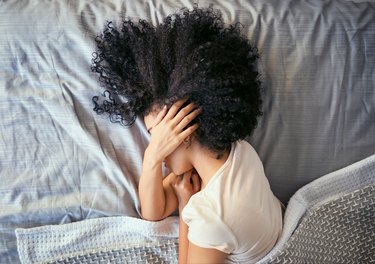
Dull and throbbing or sharp and piercing, earaches are a total, well, pain. But whether yours is caused by a bad cold, earwax buildup or too much pool time, listen up: These natural remedies for earaches (for adults and kids) will leave you feeling better, fast.
Tip
Try these home remedies to ease the pain of an earache, but be sure to see your doctor if the pain is intense or gets worse, you have a fever or trouble sleeping, or if symptoms don't resolve in two to three days.
Video of the Day
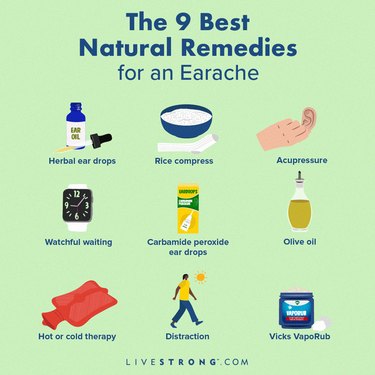
1. Herbal Ear Drops
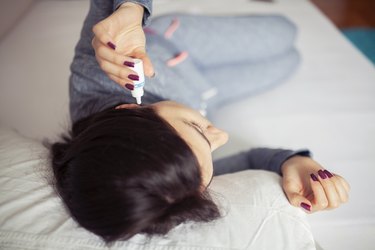
Soothe your ouchy ears with herbal drops concocted of garlic and mullein (a flowering plant with medicinal properties).
Video of the Day
A December 2019 study in Turkish Annals of Otorhinolaryngology found that garlic derivatives have antimicrobial activity against common microorganisms that cause ear infections.
In addition, a classic May 2003 clinical trial in Pediatrics found that natural ear drops containing garlic and mullein extracts helped reduce pain in children with ear infections.
According to the research (which is still cited often), these herbs have antibacterial, anti-inflammatory and antioxidant properties. They also stimulate immune response and have no known side effects.
One word of caution: "Before using ear drops, make sure there is no perforation of the eardrum," says Sunjya Schweig, MD, founder and president of the California Center for Functional Medicine, who adds that he has frequently used herbal ear drops for his own kids' ear infections. If you have a hole in your eardrum or ear tubes, then ear drops could cause damage or make things worse.
Dr. Schweig suggests you get checked out by your doctor before using ear drops, or begin treatment early in the infection phase, when you have only mild to moderate pain.
How to Use Them
You can find ear drops at most health food stores or online. Dr. Schweig gives Herb Pharm Mullein Garlic Oil ($13, Amazon) the thumbs-up.
- "Place the bottle in a cup of warm water to bring it up to body temperature, testing it on your wrist first," Dr. Schweig says.
- Then, either tilt your head to one side or lie down on your side, with the infected ear facing up.
- Put one drop (for children) or two (for adults) into the ear canal.
- Hold this position for 10 minutes.
- Use the drops twice a day until your symptoms ease up, plus one more day to help fully clear the infection.
2. A Rice Compress
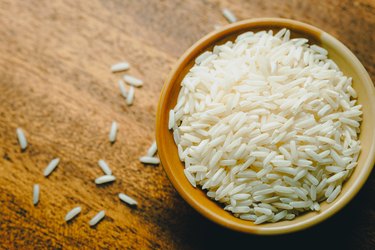
Turns out, rice isn't just for cooking.
"Ear pain may be caused by fluid buildup behind the eardrum," Dr. Schweig says. "You can use uncooked rice to draw out this fluid, similar to how placing a few pieces in a saltshaker absorbs excess moisture and prevents it from caking."
How to Use It
- Pour 1 cup of uncooked rice into a long sock and tie if off.
- Microwave it for one minute, until warm but not hot.
- Press the sock against the affected ear for 10 minutes, twice a day.
"The warmth is comforting and brings circulation to the area, while the rice will help pull out liquid," Dr. Schweig says.
3. Acupressure

According to the U.S. National Library of Medicine, acupressure is a method of applying pressure to certain areas of the body in order to relieve discomfort. It works by changing the pain signals that your nerves transmit to your brain.
"You can use acupressure points on your own face to facilitate the drainage of fluid from the ears," Dr. Schweig says. "But if you are experiencing recurrent ear infections, it's worth seeing an osteopath or craniosacral therapist, who can administer professional acupressure to open up your passageways."
How to Do It
Follow these guidelines from Dr. Schweig, using light to medium pressure, depending on how sensitive the areas feel:
- Massage down the length of your throat.
- Gently pinch your earlobes and draw down.
- On either side of your nose, just below the eye socket, there is a tender valley called the infraorbital foramen. Massage here in small, clockwise circles for 30 to 60 seconds; then counterclockwise for 30 to 60 seconds.
- Right below the inner corner of your eyebrows, above your eye sockets, is a small dip in your brow bone: the supraorbital foramen. Gently rub clockwise and counterclockwise for half a minute to a minute in each direction.
4. Watchful Waiting
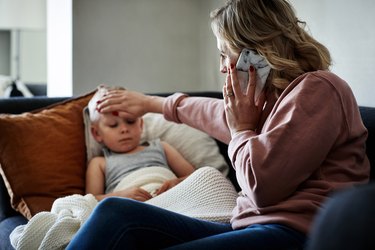
Could the best way to combat an earache be to do…absolutely nothing at all? It just might.
An April 2017 study in Pediatrics found that "watchful waiting" for two to three days in response to an ear infection both improved health outcomes and saved money.
How to Do It
Sit tight and pop an OTC pain reliever. In a December 2016 Cochrane Systems Database Review, acetaminophen and NSAIDs both effectively reduced the discomfort associated with an ear infection.
Tip
If you're giving medicine to a child, make sure to ask your pediatrician about the correct dosage.
5. Carbamide Peroxide Ear Drops
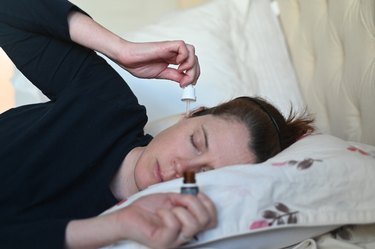
If excessive wax is causing your earache, try carbamide peroxide drops, such as Debrox Earwax Removal Kit ($11.03, Amazon). Note that this remedy is only for adults and children ages 12 and older.
"Peroxide drops can be helpful in the short term to remove wax, but don't use peroxide if you have an ear infection," Dr. Schweig says. "Studies show that it kills natural immune cells."
How to Use It:
- Tip your head to the side, with the painful ear facing up.
- Place 5 to 10 drops into your ear and hold the position for several minutes.
- Flush out wax using warm water placed in a bulb syringe.
- Use up to twice a day for four days.
6. Olive Oil
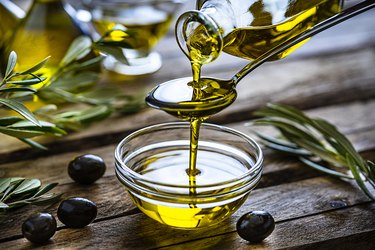
A small September 2013 study in Practice Nursing explored whether placing drops of olive oil in your ear might help free impacted earwax. The results were mixed: On its own, olive oil actually increased buildup. But when it was applied right before a doctor flushed out the ears, the wax slid out more easily.
How to Use It
Want to give it a go? Dr. Schweig suggests the following steps:
- Warm a dropper bottle of olive oil in a bowl of warm water to reach body temp.
- Apply 1 to 2 drops in your ear.
- Then, squirt warm water into your ear using a bulb syringe ($5.79, Walgreens.com).
7. Hot or Cold Therapy
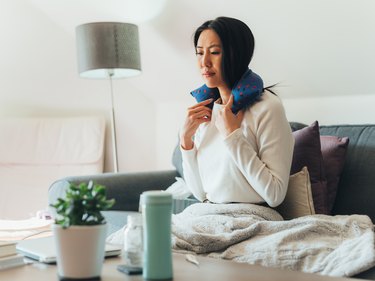
As with any bodily ache, applying heat or a cold pack to the area may help temporarily ease the pain of an ear infection. A warm compress can help relax the muscles and improve blood flow, while a cold pack can numb the pain and help reduce inflammation, according to Johns Hopkins Medicine.
How to Use It
Apply a heating pad or cold compress to the outside of the ear for about 20 minutes at a time.
8. Distraction

Sometimes the best remedy for an achy ear is to be distracted from the pain. This can be especially helpful when a child has an earache and you're employing the "watchful waiting" technique.
How to Do It
Try taking your child's mind off the pain by playing games, watching their favorite show or getting outside for a walk or some exercise.
9. Vicks Vapo Rub
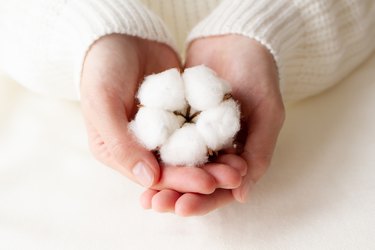
Have you heard that using Vicks Vapo Rub is good for earaches? Rumor has it, you can apply a bit of Vicks to a cotton ball and place it in your ear for several hours to ease pain.
No studies have explored its effectiveness, but Dr. Schweig isn't ruling it out: "I haven't used Vicks Vapo Rub in the ear, but the cool sensation might be distracting for pain," he says. "In addition, menthol has antibacterial properties that could open up blocked passageways."
What About Vitamins?
Although upping your vitamin intake won't cure existing ear pain, having a healthy diet can help prevent infections in the first place. "Vitamins A and D have antiviral properties and support immune function," Dr. Schweig says.
But don't double up on these vitamins unless directed by your care provider. "If you take too much, they can build up in your body and have a toxic effect," Dr. Schweig says.
Instead of popping a pill, he suggests taking one teaspoon of cod liver oil daily, which is easier for your body to absorb (since it's coming from a food source) and contains naturally occurring A and D vitamins.
Other foods high in vitamin A include:
- Sweet potato
- Carrots
- Butternut squash
- Leafy greens
Other foods high in vitamin D include:
- Fish like trout, salmon, halibut and tilapia
- Cremini and portobello mushrooms
- Fortified tofu
As for vitamin E, although it was part of the herbal ear drop formulation in the 2003 Pediatrics study, no research has been done specifically looking at its effect on ear health.
What About Supplements?
The jury's out on whether probiotic use zaps ear pain itself, but a June 2019 review in Cochrane Database Systematic Reviews found that taking a daily probiotic reduced the risk of developing an ear infection by one-third in children not prone to ear infections.
"Ear infections can be due to an imbalance in the microbiome," Dr. Schweig says. "Probiotics and fermented foods can help restore a healthy bacterial balance."
To maximize the benefits, he suggests letting a high-quality probiotic tablet dissolve on your tongue after brushing your teeth at night. He suggests those from Klaire Labs and Seed.
What About Garlic?
Some people believe that chewing on raw garlic or even sticking a clove of garlic in the ear can get rid of an earache, but there's a lack of evidence to support this.
Garlic has health benefits, but curing ear pain likely isn't one of them.
What About Ginger?
Like garlic, ginger has anti-inflammatory properties and a host of health benefits, but there's no solid research to show that raw ginger or ginger juice can help with an earache.
When to See a Doctor
The National Institutes of Health (NIH) notes that most ear infections clear up on their own after a few days — and contrary to popular belief, antibiotics are rarely necessary.
Still, Dr. Schweig says there are some instances where you should seek medical attention:
- You are in severe pain (think: throbbing pain in the ear) or the pain is getting worse.
- Your earache is accompanied by a fever.
- You're having trouble sleeping.
- Fluid is coming out of your ear.
- It hasn't improved after two to three days.
5 Things That Cause Ear Pain
There are several reasons why you might be hurting. Understanding the root cause can help you figure out the best approach.
1. A Classic Ear Infection
Called otitis media, this is the most common type of ear infection. It occurs in the middle ear, located behind the eardrum. The middle ear is connected to the throat by a passageway called the eustachian tube. According to the NIH, its role is to let in fresh air and drain out fluid.
But if you're sick or have allergies, your immune response triggers inflammation and an uptick in mucus production. "The eustachian tube is very narrow, so it can easily swell shut or get gummed up with mucus," Dr. Schweig says. "As a result, fluid can get trapped in the middle ear where it stagnates and breeds bacteria."
The buildup of pressure and fluid behind the ear drum can be intensely painful. "If the pressure gets bad enough, it can rupture the eardrum," Dr. Schweig says.
FYI: Children tend to get ear infections more frequently than adults because their eustachian tubes are skinnier and less slanted.
2. Impacted Earwax
Earwax may be gross, but it's good for your ears. It helps keep them healthy by maintaining your microbiome, lubricating your ear canals and providing protection against germs and harmful bacteria.
That said, occasionally a surplus of earwax can accumulate, which plugs up the ear canal. "If earwax is impacted, fluid can get trapped behind this blockage, leading to pain," Dr. Schweig says.
According to the Cleveland Clinic, the culprit for earwax impaction can be using Q-tips to clean your ears, wearing hearing aids or having lots of ear hair. It can also result from certain skin conditions or the anatomy of your ears.
3. Swimmer’s Ear
This type of ear infection, called otitis externa, happens when water lingers for too long in the outer part of the ear and breeds bacteria.
"In addition, chronic exposure to cold water and wind can result in the growth of polyps in the ear," Dr. Schweig says, noting that this is most commonly seen in surfers. "These polyps trap fluid in the outer ear and can cause bacterial infection."
Related Reading
4. An Ear Abrasion
Yet another reason to never put anything smaller than your elbow in your ear: "If you stick something in your ear, it can scrape against your ear canal or even perforate your eardrum," Dr. Schweig says. Ouch.
5. Ear Barotrauma
Do your ears ever hurt when the pressure changes in an airplane? That sensation is barotrauma. "It can also happen if you are at high altitude, scuba dive or even dive deeply into a pool," Schweig says.
Typically, barotrauma resolves quickly on its own; your eustachian tube opens up so that the pressure in your middle ear matches the outside air pressure. But sometimes, the eustachian tube doesn't open, and pain persists.
- Turkish Annals of Otorhinolaryngology : "Antimicrobial Activity of Garlic Derivatives on Common Causative Microorganisms of the External Ear Canal and Chronic Middle Ear Infections"
- Pediatrics: "Naturopathic treatment for ear pain in children"
- U.S. National Library of Medicine: "Nausea and acupressure"
- Practice Nursing: "Does olive oil prevent earwax build-up? An experimental study"
- Cochrane Database Systematic Reviews : "Probiotics for preventing acute otitis media in children"
- NIH: "Pain in the Ear"
- Pediatrics: "Cost-Effectiveness of Watchful Waiting in Acute Otitis Media"
- Cochrane: "Pain relievers for children with acute middle ear infection"
- Cleveland Clinic: "Earwax Buildup & Blockage"
- Johns Hopkins Medicine: "Ice Packs vs. Warm Compresses For Pain"
Is this an emergency? If you are experiencing serious medical symptoms, please see the National Library of Medicine’s list of signs you need emergency medical attention or call 911.